Identification of Phyllosoma Larvae of the Lobsters Acantharctus and Biarctus (Crustacea: Scyllaridae) from the SW Indian Ocean
- PMID: 37772163
- PMCID: PMC10522623
- DOI: 10.6620/ZS.2023.62-33
Identification of Phyllosoma Larvae of the Lobsters Acantharctus and Biarctus (Crustacea: Scyllaridae) from the SW Indian Ocean
Abstract
The accurate assignment of cryptic larvae to species-level is a key aspect of marine ecological research and can be achieved through integrated molecular and morphological studies. A combination of two mitochondrial markers (COI and 16S) and a detailed morphological analysis was used to identify phyllosoma larvae of slipper lobster (Scyllaridae) species collected during a survey in the SW Indian Ocean. Two morphotypes were tentatively assigned to Acantharctus ornatus and Biarctus pumilus, both genera for which the larval morphology was unknown. Morphological revision of an adult specimen used to generate the putative A. ornatus sequences in GenBank revealed that it was misidentified and corresponds to B. dubius. The final phyllosoma stage of B. pumilus and subfinal and final stages of A. ornatus were described, clarifying prior misidentifications in the literature. Scyllarid biodiversity in the SW Indian Ocean is underestimated and sampling of deeper water layers is recommended to complete current knowledge of species and larval stages present in the region.
Keywords: KwaZulu-Natal Bight; Morphological description; Phyllosomas; SW Indian Ocean; South Africa.
Figures



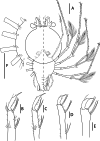
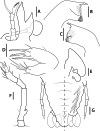
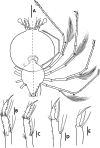
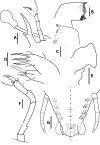
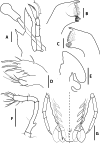
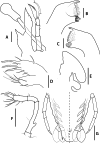
References
-
- Atkinson JM, Boustead NC. 1982. The complete larval development of the scyllarid lobster Ibacus alticrenatus Bate, 1888 in New Zealand Waters. Crustaceana 42:275–287. doi:10.1163/156854082X00344.
-
- Baez P. 1973. Larvas phyllosoma del Pacífico Sur Oriental (Crustacea, Macrura, Scyllaridea). Rev Biol Mar 15:115–130.
-
- Barnett BM. 1989. Final-stage phyllosoma larvae of Scyllarus species (Crustacea: Decapoda: Scyllaridae) from shelf waters of the great barrier reef. Invert Syst 3(2):123–134.
-
- Barnett BM, Hartwick RF, Milward NE. 1984. Phyllosoma and nisto stage of the Moreton bay bug, Thenus orientalis (Lund) (Crustacea: Decapoda: Scyllaridae), from shelf waters of the great barrier reef. Mar Freshw Res 35:143–152. doi:10.1071/MF9840143.
-
- Berry PF. 1974. Palinurid and Scyllarid lobster larvae of the Natal coast, South Africa. Invest Rep Oceanogr Res Inst 34:1–44
LinkOut - more resources
Full Text Sources
